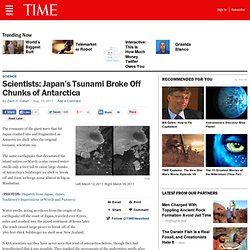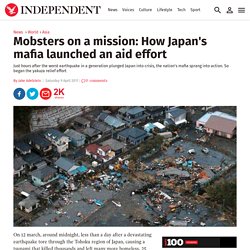

Scientists: Japan’s Tsunami Broke Off Chunks of Antarctica. The remnants of the giant wave that hit Japan crashed into and fragmented an Antarctic ice shelf after the original tsunami, scientists say.

The same earthquake that devastated the island nation on March 11 also caused water swells only a foot tall to cause large chunks of Antarctica’s Sulzberger ice shelf to break off and form icebergs, some almost as big as Manhattan. (PHOTOS: Dispatch from Japan: James Nachtwey’s Impressions in Words and Pictures) Water swells, acting as echoes from the origin of the earthquake off the coast of Japan, traveled over 8,000 miles and crashed into the island continent 18 hours later. The crash caused large pieces to break off of the 260-feet-thick Sulzberger ice shelf near New Zealand.
NASA scientists say they have never seen that kind of interaction before, though they had hypothesized that it was possible. “We knew right away this was one of the biggest events in recent history — we knew there would be enough swell. (PHOTOS: Ice Land) Suicide rates are increasing in Japanese regions most effected by the tsunami and nuclear disasters. People pray at a shrine for victims three months after the magnitude 9.0 earthquake and subsequent tsunami, in Natori, Miyagi, Japan.

Source: Getty Images THE Japanese Government has warned of an epidemic of depression and suicide as a result of mental trauma caused by the earthquake, tsunami and ongoing nuclear disaster. The country already has one of the highest suicide rates in the world, but new figures show that the number of deaths has risen almost a fifth compared with a year ago. In Miyagi, the region worst hit by the March 11 tsunami, the figures are especially alarming, with suicides up 39 per cent.
A government report is now warning that the stoicism of many victims in the early weeks of the disaster may mask post-traumatic stress disorder. "As well as grief, survivors also experience guilt because, although they tried to escape together, only some were saved. The observations appear to be reflected in the new figures, which show an 18 per cent national increase in suicides.
Mobsters on a mission: How Japan's mafia launched an aid effort - Asia, World. On 12 march, around midnight, less than a day after a devastating earthquake tore through the Tohoku region of Japan, causing a tsunami that killed thousands and left many more homeless, 25 trucks bearing 50 tonnes of supplies arrived in front of the City Hall in Hitachinaka, in the east-coast Ibaraki prefecture.

A hundred men in long-sleeves shirts and coats immediately began unloading the boxes. These men weren't the Red Cross. They were members of Japan's third-largest organised crime group, the Inagawa-kai. They had all taken great care to cover up their affiliation. Sleeves were rolled down to hide the ornate tattoos that characterise so many of Japan's yakuza members; those who were missing fingers all wore gloves. They came under the cover of the night because they didn't want their donations to become a public affairs issue. Hitachinaka City Hall employees understood who they were. The Japanese have been here before. The aid delivery to Hitachinaka was not an isolated incident. Dix idées fausses sur le séisme et le tsunami au Japon. How the 2011 Japan tsunami happened.